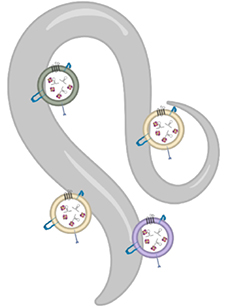HALO Director Dr. Matt Kaeberlein along with HALO faculty member Dr. Mike MacCoss, post-doctoral fellow Dr. Josh Russell, and colleagues have published the first comprehensive analysis of the extracellular vesicles (EVs) from Caenorhabditis elegans, one of the foremost animals models for aging and other areas of research. This work builds on the method developed by Drs. Russell and Kaeberlein which was published earlier this year in the Journal of Visualized Experiments.
EVs are small membrane-bound particles that are secreted by cells into their external environment. They contain proteins, metabolites, lipids, and nucleic acids. EVs have become widely recognized for their importance in intercellular communication, which is perturbed during aging. There is also abundant evidence that pro-longevity signals are communication via cell non-autonomous mechanisms which may involve EV signaling. This new study shows that the composition of C. elegans EVs closely resembles those of humans and suggests that this system can be used to study the basic biology of EVs and how they contribute to a variety of diseases, as well as the aging process itself.
See the full article here: https://link.springer.com/article/10.1007%2Fs11357-020-00204-1
Full citation: Russell JC et al. (2020) Composition of Caenorhabditis elegans extracellular vesicles suggests roles in metabolism, immunity, and aging Geroscience doi:10.1007/s11357-020-00204-1
